�
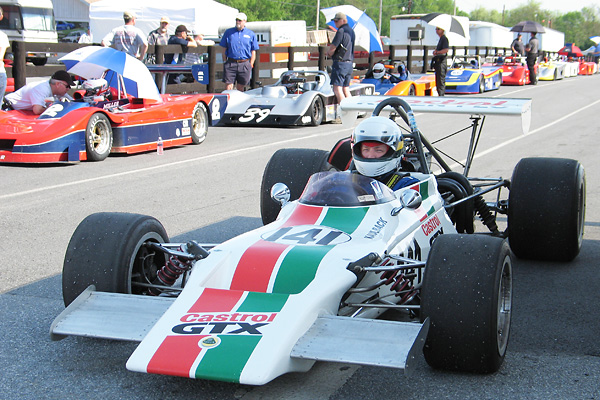
�
Kyle Kaulback's 1971 Lotus 69 Formula B (Upgraded) Racecar
� � Owner: Kyle Kaulback� City: Bethel Pennsylvania
� Model: 1971 Lotus Type 69
� Engine: Ford Cosworth 1600cc BDA
� Race prepared by: Powerslide Motorports�
�
Lotus Components Ltd. and the Lotus Type 69
��
Lotus Components Ltd. was founded to design, build, and sell racecars. Separating out Lotus�
Components allowed Colin Chapman's core business, Lotus Cars, to focus on passenger car production.�
Simultaneously Chapman's real passion, Team Lotus, could develop and race Formula One cars without�
distraction. In so many ways, Lotus Components seemed like a very good idea. The outfit grew and�
evolved through the sixties, changed its name to Lotus Racing Ltd., and then collapsed in the early�
seventies. This article is about one of Lotus Racing's final products: Kyle Kaulback's Lotus 69.�
�
Lotus evidently liked the name 69 so much that they applied it to three different car�
models. Many sources will tell you that variants of the Type 69 were specifically designed for�
Formula Two, Formula Three, and Formula Ford respectively.¹ Additionally, some of the Formula Three�
Type 69's were set-up for racing in North America's Formula B class. Exactly one Formula Two Type 69�
was bought second hand, heavily modified by its owner, and then entered in two Formula One races.�
Surely the Lotus Type 69 must have been one of the most versatile racecars ever built, right?�
�
Consider this: the Formula Two Type 69 had a semi-monocoque chassis from the�
firewall forward whereas Formula Fords weren't even allowed to have stressed skins! Furthermore,�
Formula Two and Formula Ford Type 69s had entirely different suspensions and brake packages - �
distinct designs with no shared parts. The Formula Two Type 69�
had huge racing slicks on magnesium wheels, whereas the Formula Ford Type 69 raced on skinny�
treaded street tires and steel disc wheels. Perhaps from some angle the bodywork may have looked�
similar, but no part of it was interchangeable. The Formula Two body was wide in the middle�
to house fuel cells, and big wings were attached at both front and rear. Openings for radiators�
were sized differently. And then there was a Formula Three Type 69: somewhere between the two�
extremes and truly its own distinct model too. A potential customer (or modern historian)�
might have great difficulty pinning down an accurate definition of its unique features. We'll try.�
�
How successful were these cars on the racetrack? In his Type 69, Jochen Rindt dominated the first�
Formula Two race of the 1970 season but focused on Formula One through mid-season. (Rindt died�
tragically while testing his Lotus Formula One car for the Italian Grand Prix race in September�
1970.) In 1971, Emerson Fittipaldi drove a Formula Two 69 to five victories. In summary, the�
Formula Two 69 proved very competitive when in the right hands, but never scored enough championship�
points to really shine.�
�
The Formula Three Lotus 69 was introduced a year later, in 1971, and in that year Dave Walker drove his�
Ford Twin Cam powered Formula Three 69 to 25 wins from 32 starts to win two different Formula Three�
championships in one year. (Walker was particularly successful late in the season, after a rule change�
regarding restrictor plates sped up the whole field.) �
�
Evidently sales weren't brisk enough to make the division profitable. Colin Chapman pulled the plug�
on Lotus Racing Ltd. before the end of 1971, and all the Type 69 models were discontinued. (Incidentally,�
many core members of the team who created the Type 69 models moved on to form a new company called�
Group Racing Developments.)�
Team Lotus developed and raced a Type 73 F3 car in 1972 and a Type 74 F2 car in 1973, but their�
hearts weren't really in these class; they were a Formula One team.�
�
The Lotus 69 featured in this article is a unique hybrid between the original Formula Two and�
Formula Three Lotus Type 69 models. This particular specimen combines a Formula Three chassis with�
bodywork repainted accurately in its original livery, but upgraded with an engine that would have�
been suitable for Formula Two racing. In this article we'll focus on our specimen, and thus�
generally on Lotus' Formula Three Type 69. �
�
�
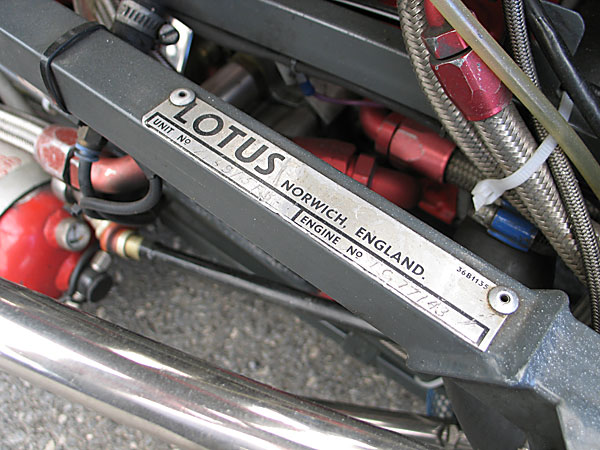
�
Lotus - Norwich, England
�
Unit No.: 71/69/5FB. Engine No.: TC77143.
�
Kyle Kaulback's Lotus 69 Formula B: 71/69/5FB
��
Kyle's Lotus Type 69 racecar is chassis number 71/69/5FB², which features a Formula Three spec tubular�
steel chassis. In other words, the frame is basically similar to a Formula Ford frame except reinforced�
with lightweight aluminum stressed skins. The "FB" part of its serial number designates that it was�
built up to North American Formula B specifications and delivered complete with a 1600cc Lotus/Ford�
Twin Cam engine. In Formula B, the car would be more powerful than a contemporary Formula Three car�
because it wouldn't be required breath through a single small restrictor plate. In its original�
Formula B configuration Kyle's car would have wings as shown here, but would also have been obliged�
to wear treaded racing tires instead of racing slicks.�
�
The history of Craig's Lotus 69 started auspiciously: Lotus featured it on their stand at the 1971�
Motor Racing Show, in London. After the show, it was shipped to a Canadian driver named Craig Hill.�
Craig was an important figure in Canadian racing for several reasons, not least of them was that he�
was the advertising and promotions manager for Castrol Canada. In that capacity he coordinated�
Castrol's involvement in all forms of motorsport. Craig Hill had also earned special treatment�
from Lotus by winning Canada's Formula B championship in both 1969 and 1970 as a privateer.�
Unfortunately, Formula B fizzled out in Canada just as Hill received his Lotus 69. Hill raced�
the car in an assortment of Formula Atlantic races on both sides of the Canadian / United States�
border, but with limited success.�
�
Craig moved on, and his Lotus 69 FB passed to Ron Shantz and then apparently through a succession�
of North American owners. After some years of club racing, it ended up back in England for chassis�
restoration and installation of a 1600cc Cosworth BDA (i.e. belt drive) engine and Lucas mechanical�
fuel injection. A German enthusiast named Claudia Neuhaus owned and occasionally raced 71-69-5FB�
in the late 1990s. Kyle purchased the car from Ms. Neuhaus and had it shipped back across the�
Atlantic again.�
�
�
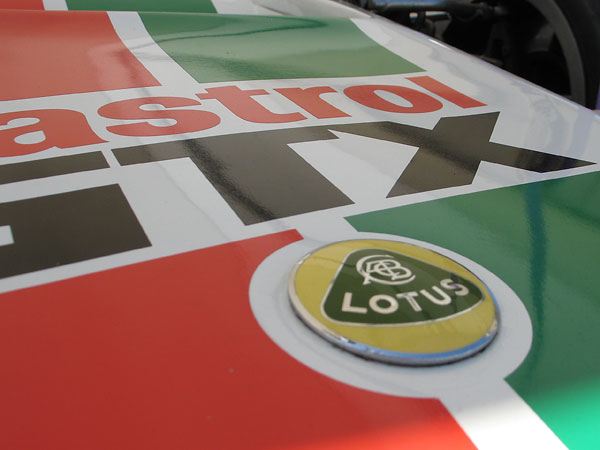
�
The ex-Craig Hill Lotus 69 Formula B: restored and wearing its original Castrol GTX livery.
�
�
Kyle's 69 was yellow with a green stripe when he received it and he raced it in those colors�
for several years. He had just returned the car to resplendent Castrol GTX livery shortly�
before we photographed it in May 2010.�
�
Ironically, returning other aspects of the car to original specification would be rather�
expensive and would simultaneously make the car slower. Different vintage racing organizations�
have different rules. As currently configured with its very potent powerplant, Kyle's car is�
eligible to race in Monoposto Racing's "Formula Atlantic" class. This class permits later 1970s era�
open-wheel cars which produce more downforce, so taking a checkered flag is both a huge challenge�
and a great thrill. Kyle's victory in The Jefferson 500 at Summit Point in 2009 was just�
that sort of victory. Kyle explained: "At least I have a good motor. My particular Cosworth BDA�
makes in the range of 250 horsepower... The 69's lack of downforce relative to a March 79 or Ralt�
RT1 is at least an advantage on the straights because the 69 has much less aerodynamic drag."
�
�
 �
�
�
�
Features and Specifications
�| Engine: | �Ford / Cosworth 1600cc BDA, rebuilt by Marcovicci-Wenz Engineering.�
Lucas Mk2 mechanical fuel injection.�
ITG foam air cleaner.�
Lucas distributor.�
Lucas ignition coil.�
Micro Dynamics electronic rev limiter.�
Magnecor Electrosports 70 (7mm) SS25-200T metallic inductor EMI suppression spark plug wires. | �
| Cooling: | �custom aluminum crossflow radiator.�
Coolant plumbed through frame tubes. �
Custom fabricated aluminum header tank. | �
| Exhaust: | �custom 4-into-1 header, ceramic coated. | �
| Transaxle: | �Hewland FT200 5-speed.�
Metalastic donuts. | �
| Front Susp.: | �unequal length wide-based wishbones.�
Proprietary Lotus magnesium uprights.�
Koni 3012 double adjustable aluminum bodied coilover shock absorbers, with Eibach springs.�
Adjustable anti-sway bar. | �
| Rear Susp.: | �inverted lower wishbones, single top links, and twin adjustable trailing links.�
Proprietary Lotus magnesium uprights.�
Koni 3012 double adjustable aluminum bodied coilover shock absorbers.�
Adjustable anti-sway bar. | �
| Brakes: | �(master) dual Girling integral-reservoir master cylinders with bias bar. � (front) Girling AR brake calipers and solid rotors. � (rear) Girling NR brake calipers and solid rotors. | �
| Wheels/Tires: | �Lotus magnesium alloy 4-stud racing wheels (13x10 front, 13x14 rear).�
Avon racing slicks (9.0/20.0-13.0 front, 12.0/23.0-13.0 rear). | �
| Electrical: | �Tilton Super Starter XLT gear reduction starter. | �
| Instruments: | �(left to right)�
Racetech coolant temperature gauge (30-110C),�
Smiths Chronometric (a.k.a. cable-driven) tachometer (400-12500rpm),�
Racetech dual oil pressure (0-160psi) and oil temperature (30-120C) gauge, and�
Racetech fuel pressure (0-160psi) gauge. | �
| Fuel System: | �dual side-mounted fuel tanks.�
Electric fuel pump for starting.�
Lucas belt-drive mechanical fuel pump for racing. | �
| Safety Eqmt: | �Schroth six point cam-lock safety harness.�
Hybrid Lifeline / S.P.A. (Fire Fighter) electrically actuated centralized fire suppression system. | �
| Weight: | �1040# | �
| Racing Class: | �currently eligible for Monoposto Racing's "Formula Atlantic" class. | �
Engine Installation
��
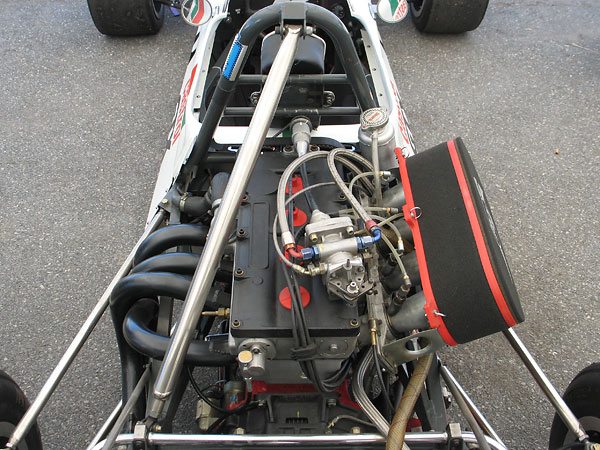
�
1600cc Ford / Cosworth BDA engine, recently rebuilt by Marcovicci-Wenz Engineering.
�
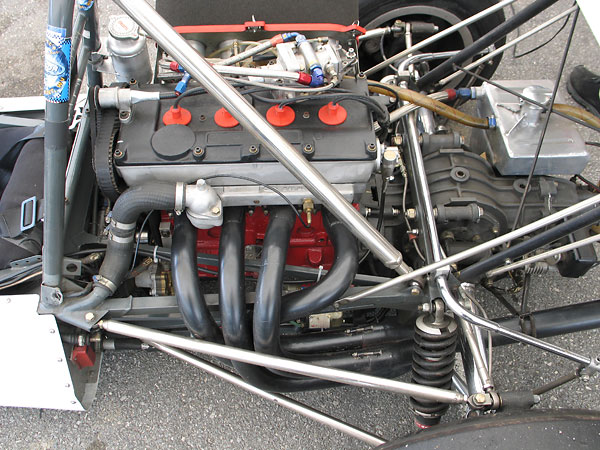
�
Custom 4-into-1 header, ceramic coated.
�
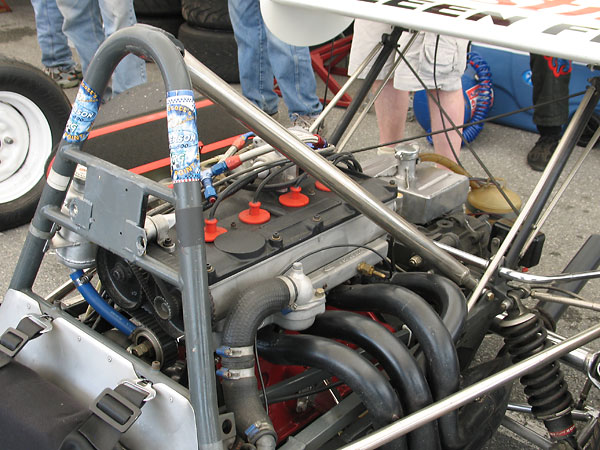
�
The roll hoop is tall, and its offset rear brace provides generous clearance to the engine.
�
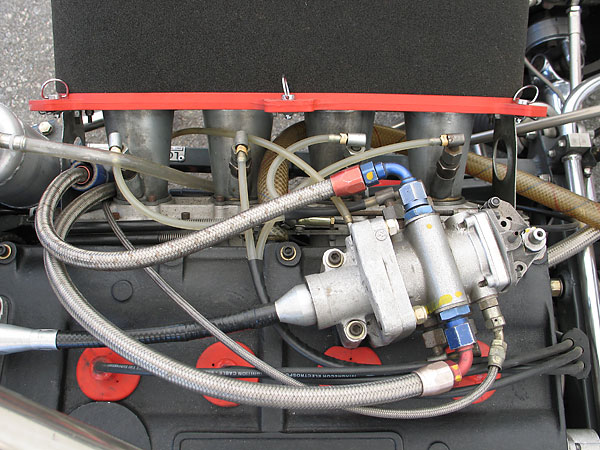
�
Lucas Mk2 mechanical fuel injection metering valve.
�
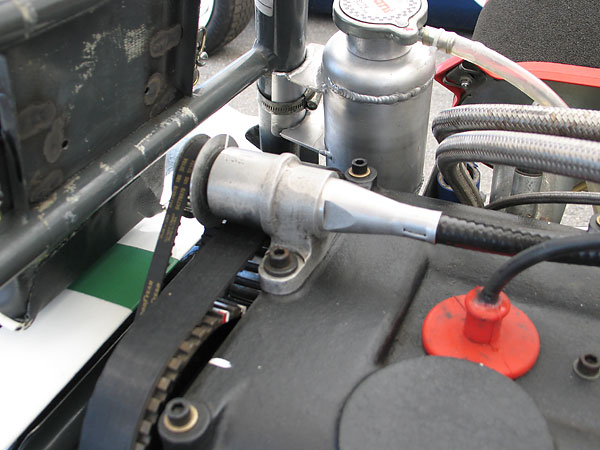
�
Fuel metering is timed based on a cogged belt driven from the exhaust-side camshaft.
�
Notice the little painted tic marks that simplify alignment upon reassembly
�
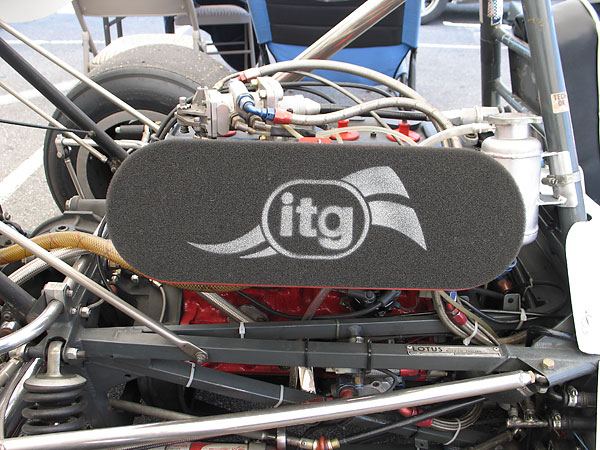
�
ITG foam air cleaner.
�
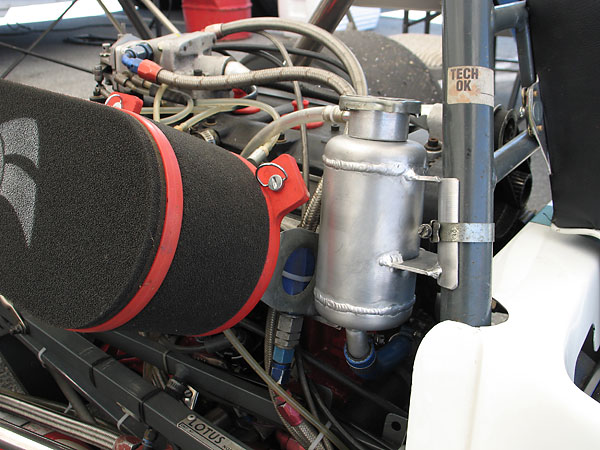
�
Custom fabricated aluminum coolant header tank.
�
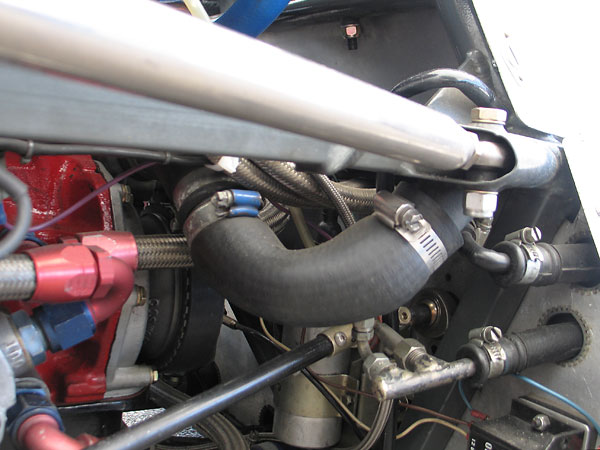
�
The name "Cosworth" is cast right into the cogged aluminum pulleys which turn dual overhead
�
camshafts. This part of Cosworth's classic BDA design, where BDA stands for Belt Drive A-Type.
�
Earlier Cosworth dual overhead camshaft engines utilized gear driven camshafts.
�
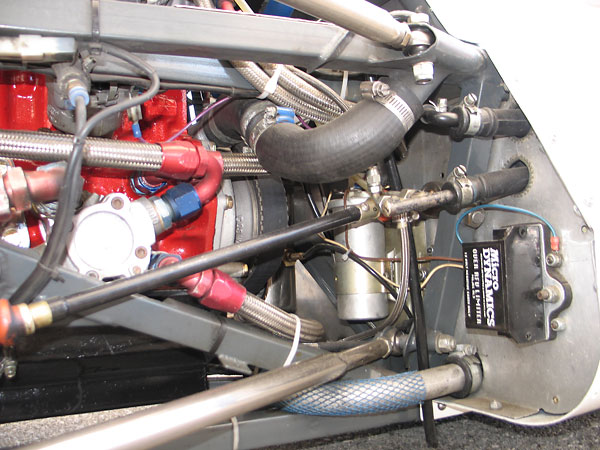
�
Micro Dynamics electronic rev limiter.
�
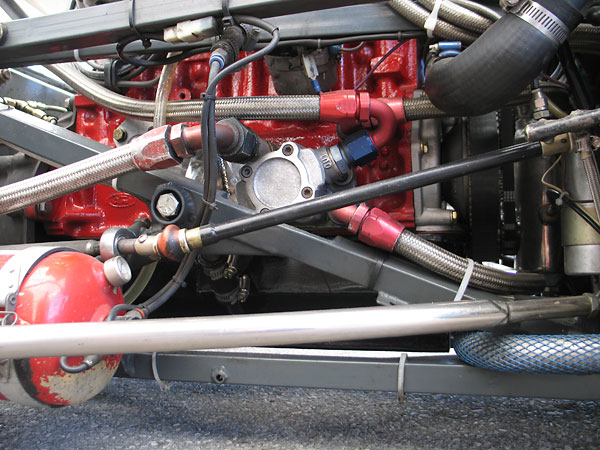
�
Dry sump lubrication system plumbing, including a special oil pump.
�
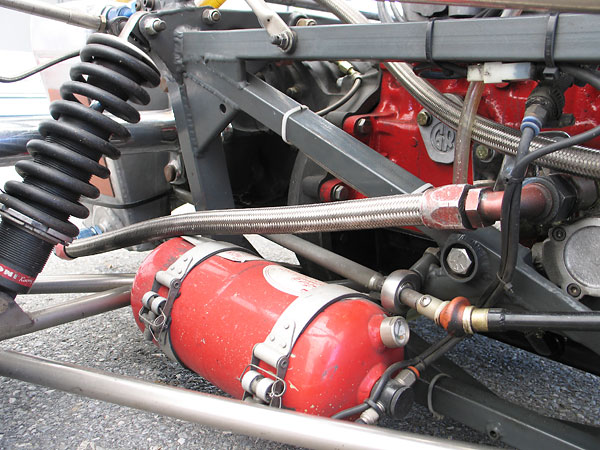
�
S.P.A. Fire Fighter fire extinguisher bottle. The fire suppression system can be actuated from a button
�
on the dashboard. It has multiple nozzles, including one located here under the engine's fuel injectors.
�
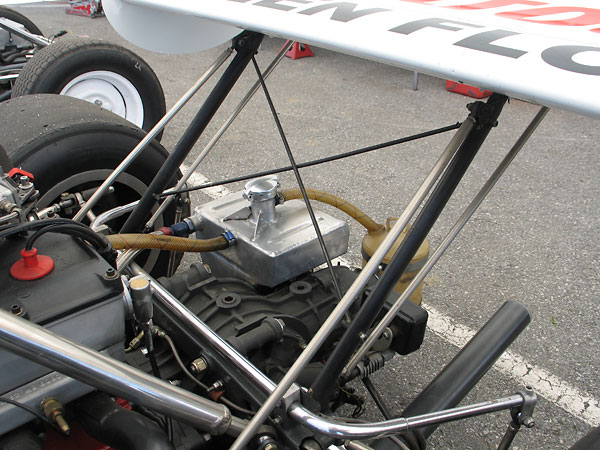
�
Rear wings are most effective when mounted far rearward, as seen here, because airflow here
�
is less turbulent and because the wings mounts act as lever arms (i.e. they provide "leverage".)
�
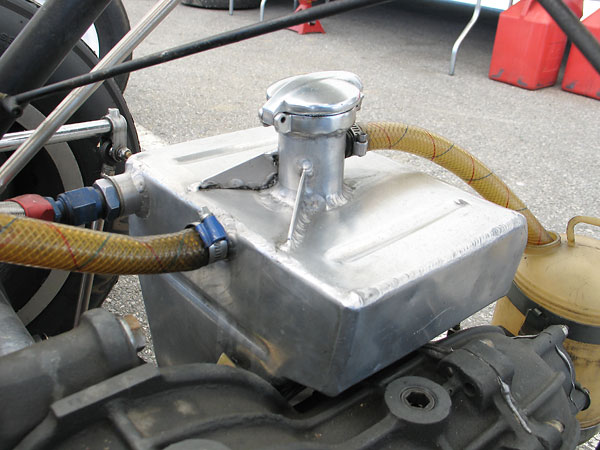
�
This elaborate fabricated aluminum engine oil reservoir is a distinctive Type 69 feature.
�
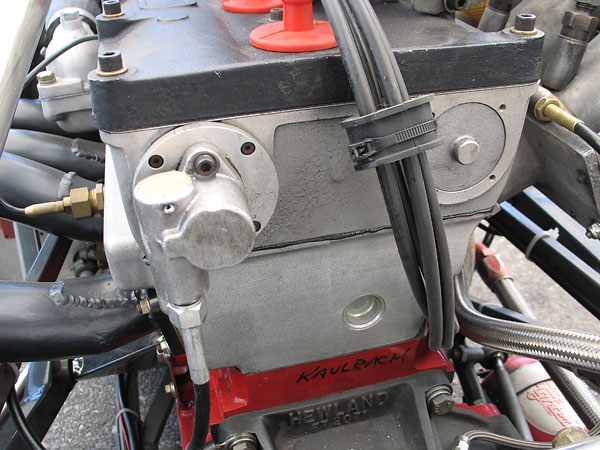
�
This is the drive for a cable-driven fully mechanical chronometric tachometer.
�
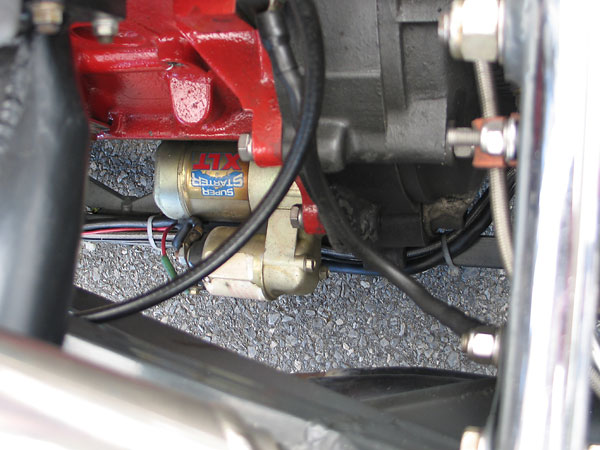
�
Tilton Super Starter XLT gear reduction starter.
�
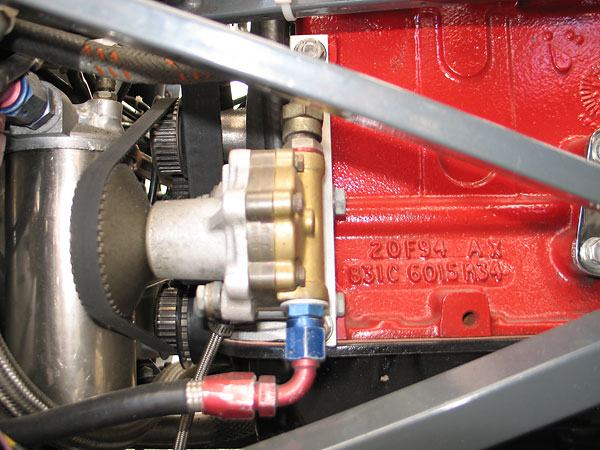
�
At left: Lucas high pressure mechanical fuel pump. At right: codes on the engine block casting can be
�
interpreted as follows. 20F94 is a date code that indicates this particular engine block was
�
cast on February 20, 1994. AX indicates that this is a South African made engine block. (Ford
�
used these engines in South African built Sierras.) "831c 6015 r34" is basically a part number.
�
Blocks with this part number were originally designed for motorsport and were originally cast
�
in England in the 1980s. These blocks weigh ~10# more than other Ford Kent crossflow blocks.
�
�
Front Suspension
��
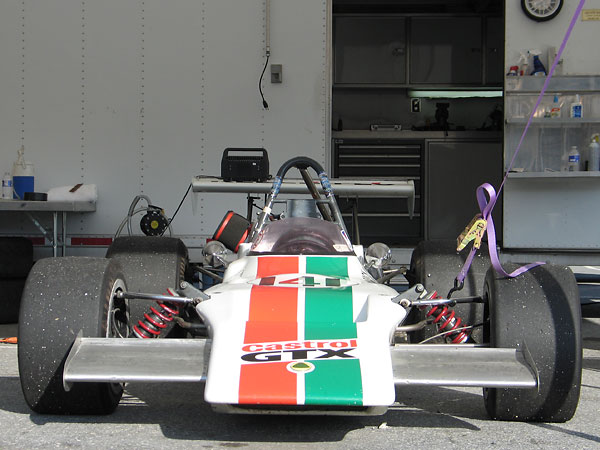
�
Wide tires widely separated.
�
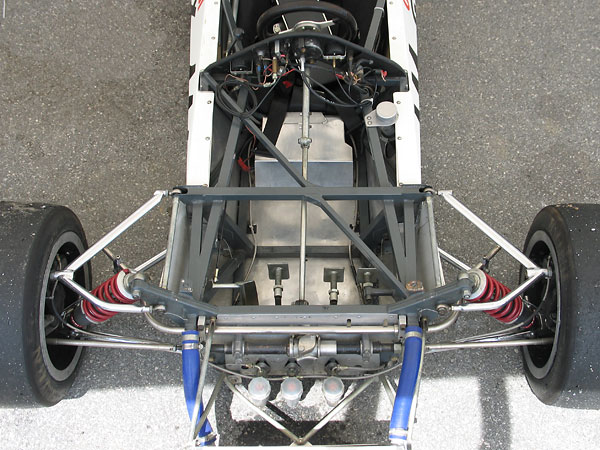
�
A variety of square and rectangular box tubing sizes were used in Type 69 F3/FF frames. Whereas
�
round section tubing is stronger and more weight efficient for a pure spaceframe, box tubing can
�
be a smart compromise in many situations. For one, it's much easier to attach sheetmetal panels to.
�
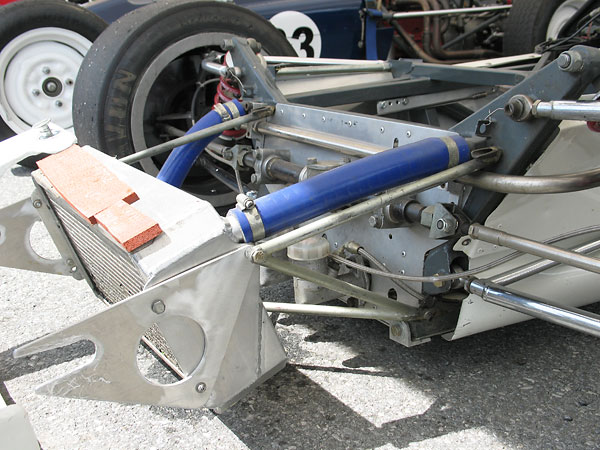
�
Now that's a thick radiator core! Note also a sacrificial "skid plate" at the corner of the frame.
�
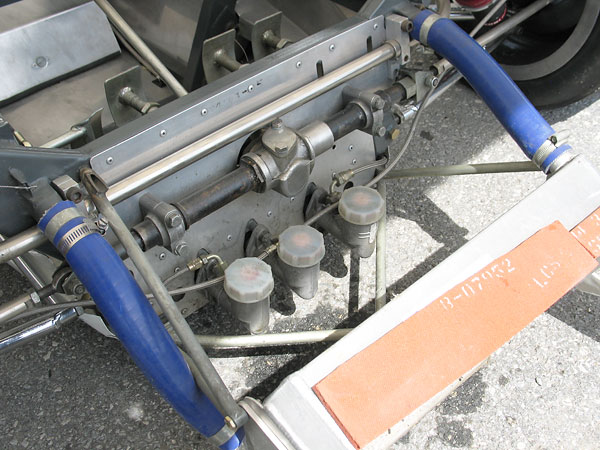
�
Girling master cylinders.
�
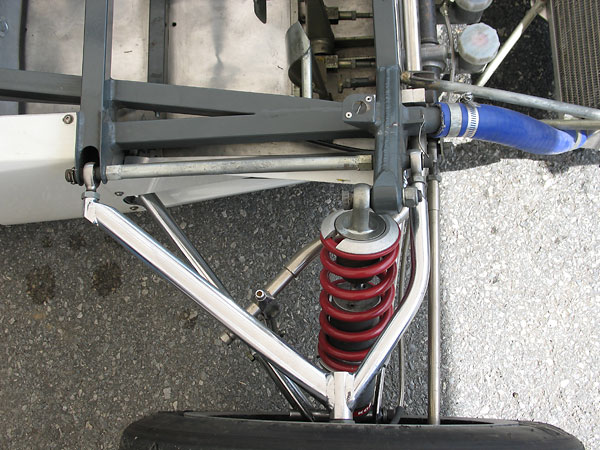
�
Koni 3012 double adjustable aluminum bodied coilover shock absorbers, with Eibach springs.
�
Note: mounting bolts for the upper wishbone screw into opposite ends of a removable bar.
�
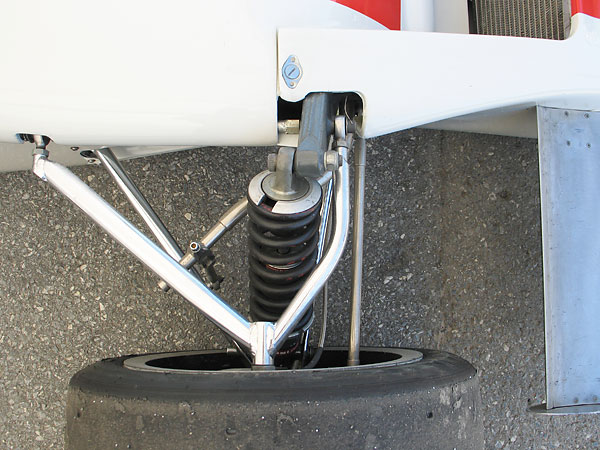
�
(These stiffer springs were installed on the car when it arrived at Summit Point.)
�
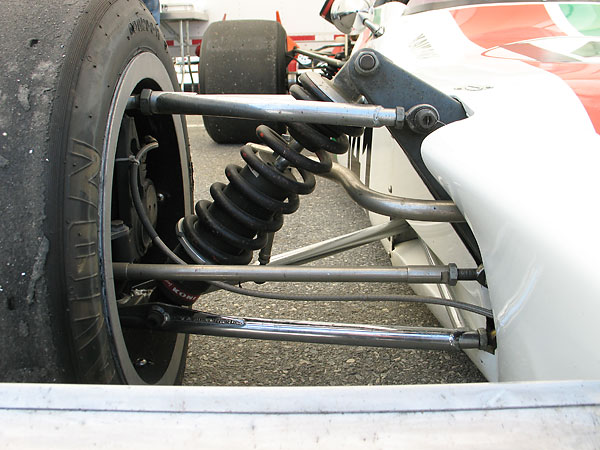
�
Interestingly, a third member connects the inboard arms of the wishbone yet the
�
anti-sway bar connection is at mid-span and is in single shear.
�
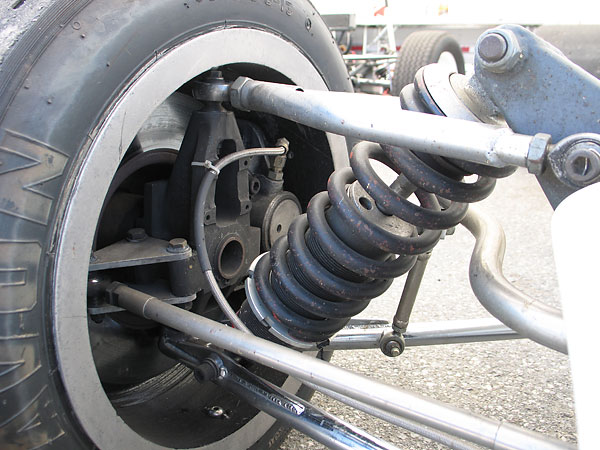
�
Bespoke magnesium uprights. Notice how the steering connection is both strong and easy
�
to adjust up or down as required for tuning out bump steer.
�
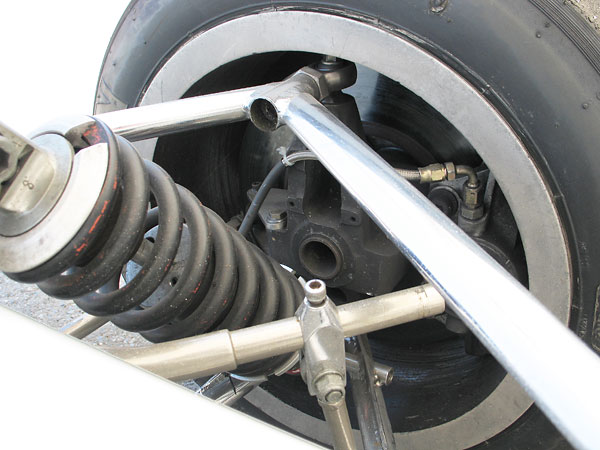
�
Why does the anti-sway bar step down in diameter at its ends? Probably it's a lightweight tubular
�
bar with solid sections at both ends to take adjustment clamp pressure without distorting.
�
�
Enjoying this article? www.BritishRaceCar.com is partially funded through generous support from readers like you!
�
To contribute to our operating budget, please click here and follow the instructions.
�
(Suggested contribution is twenty bucks per year. Feel free to give more!)�
Rear Suspension
��
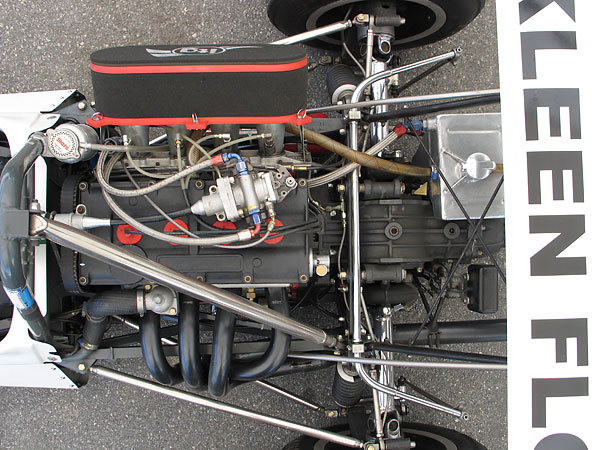
�
Inverted lower wishbones, single top links, and twin adjustable trailing links.
�
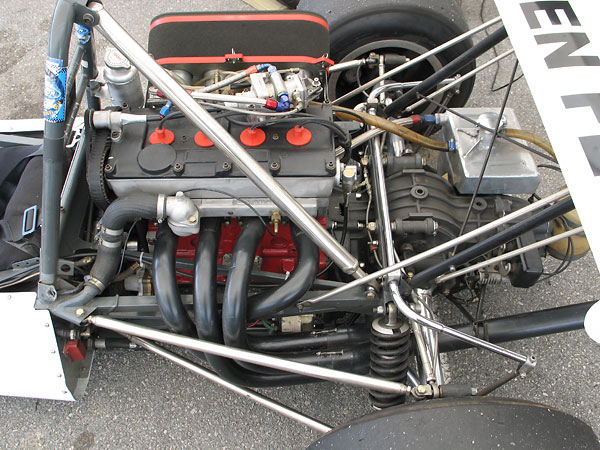
�
Hewland's FT200 transaxle looks so svelte in this view, but inside it's quite robust.
�
Introduced in 1966, FT200 boxes have backed up generations of mid-range formula cars.
�
Nominally rated for 300hp, they can in fact support much more (~500hp!) depending on
�
what ring and pinion ratio is selected and which differential is used.
�
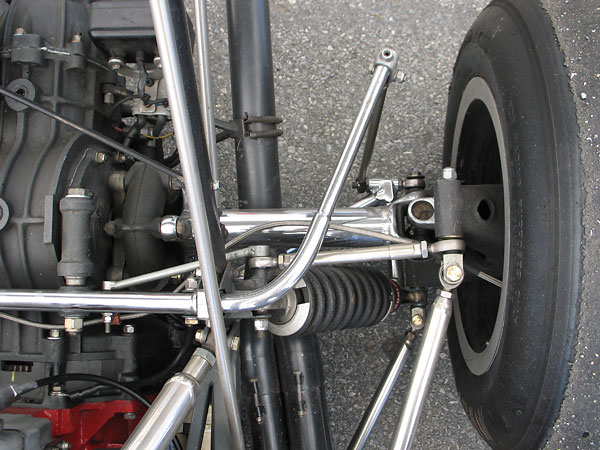
�
The rear anti-sway bar has been adjusted to its absolute softest setting.
�
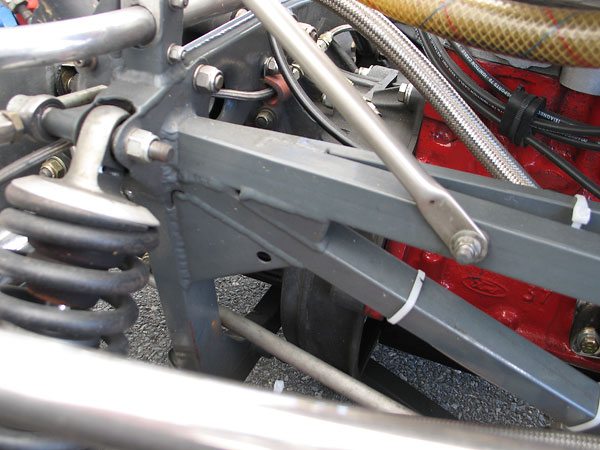
�
Michael Costin's influence on early Lotus chassis designs is echoed here in the perforated
�
member that reaches across the transaxle. Costin's design approach was very elegant and theoretical,
�
whereas Lotus 69 designer Dave Baldwin's use of gussets and box tubing was all about practicality.
�
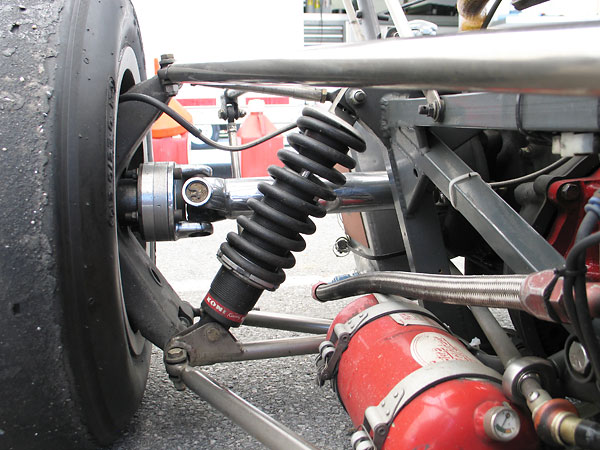
�
Koni 3012 double adjustable shocks can be adjusted for rebound on the car by "sweeping" a
�
recessed adjustment pawl at the top eye from side to side. Adjusting compression requires
�
removing the shocks and extending them to their full length, then rotating the shaft.
�
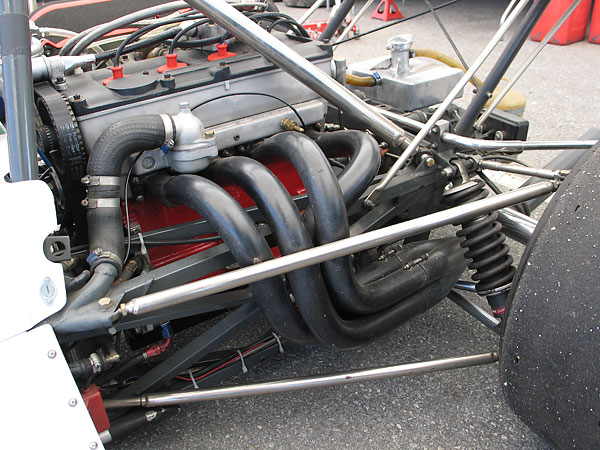
�
Another view of the trailing links...
�
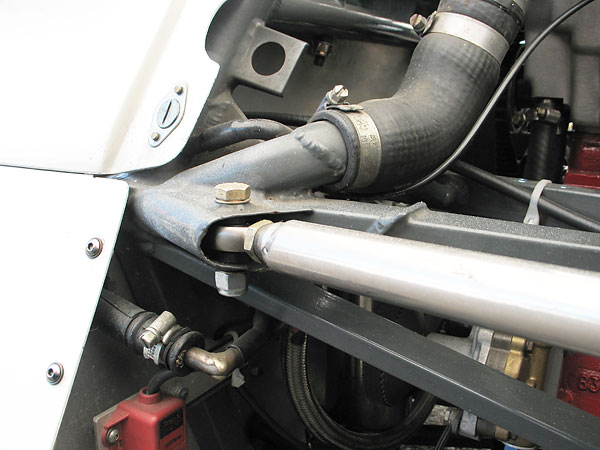
�
To run engine coolant through square section frame tubes, round tube sections needed to be
�
spliced on. Note also the diagonal splice, where fluid is blocked off from rearward flow.
�
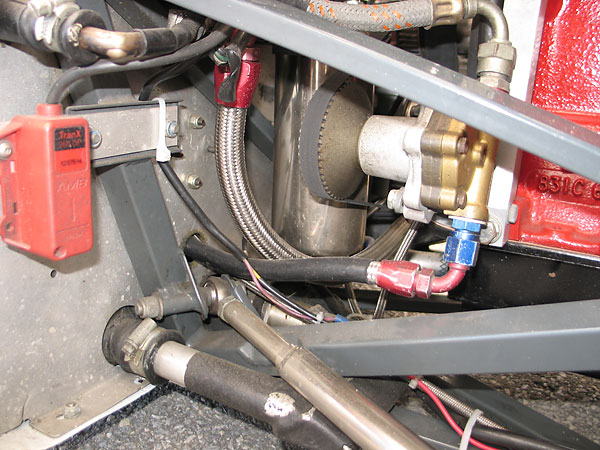
�
Someone knew exactly where they wanted this suspension pivot point, and went to a great deal
�
of effort to make it happen. Note also an elaborately fabricated triangular tube evidently
�
equalized fuel level between the dual fuel tanks.
�
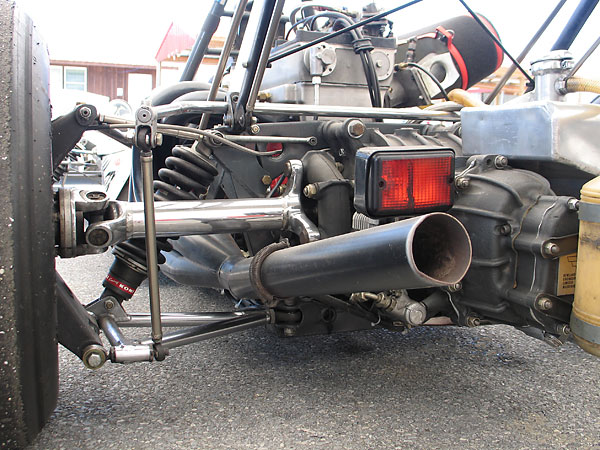
�
Metalastik couplings transfer power smoothly and simply.
�
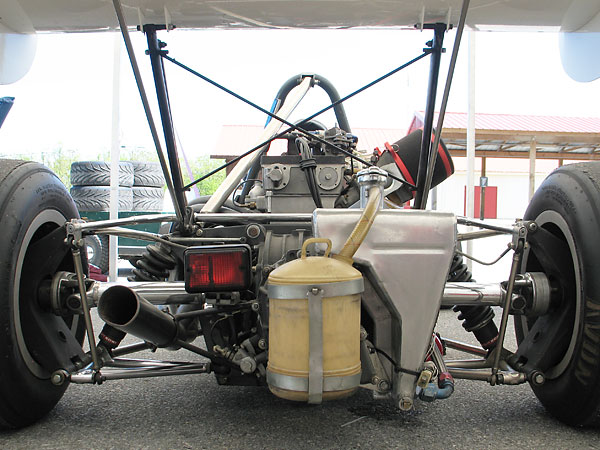
�
The Lotus 69 F3 engine oil reservoir is exceptionally distinctive.
�
�
Interior
��
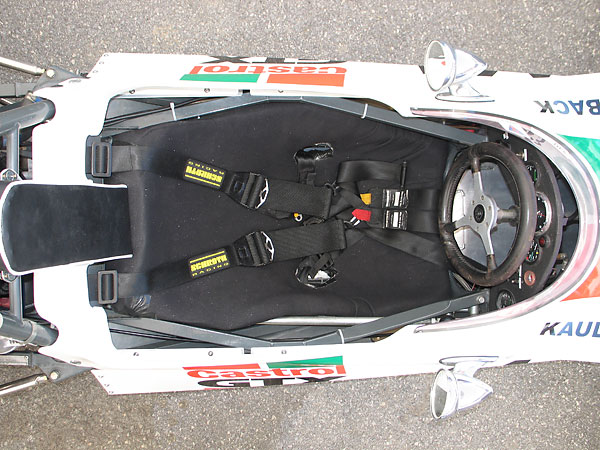
�
Schroth six point cam-lock safety harness.
�
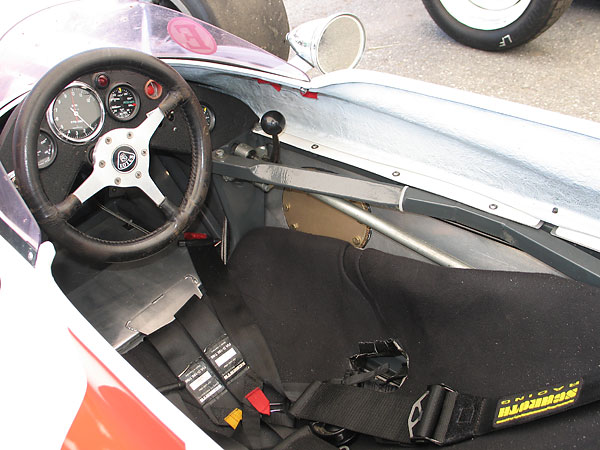
�
A recessed red button on the dashboard activates the fire suppression system.
�
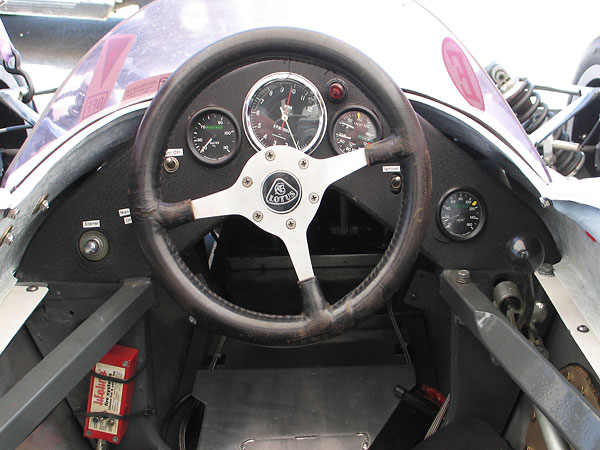
�
(left to right) Racetech H2O temp gauge, Smiths Chronometric tachometer (400-12500rpm),
�
Racetech dual oil pressure and oil temperature gauge, and Racetech fuel pressure gauge.
�
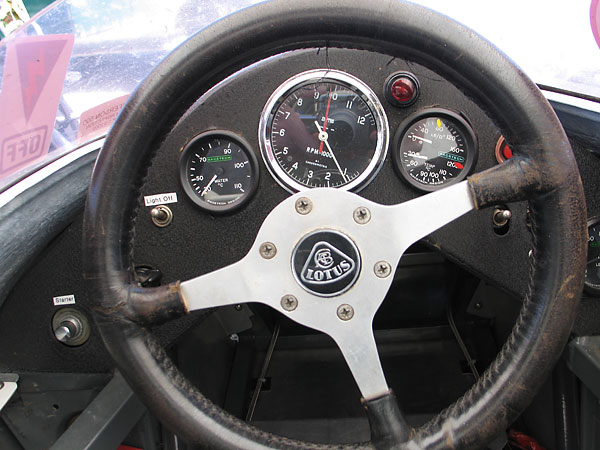
�
The tell-tale needle on the tachometer indicates that the engine has seen ~9750rpm recently.
�
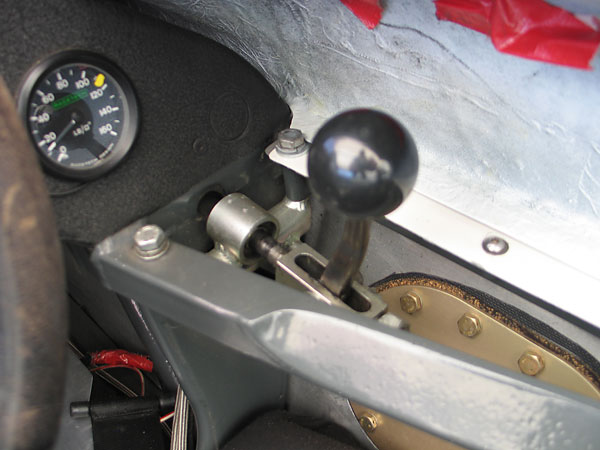
�
The fuel pressure gauge is marked at 110psi. Cars with mechanical fuel injection generally have
�
two pumps. An electric pump is used for initially starting the engine. An engine driven pump
�
is used during actual racing conditions.
�
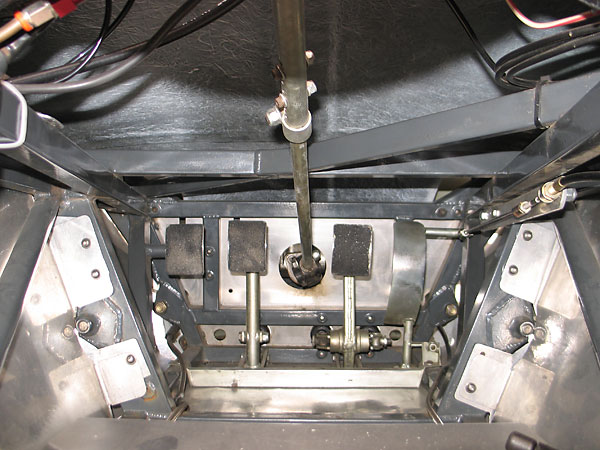
�
Two driver-friendly features: a stout dead pedal and a telescoping steering column.
�
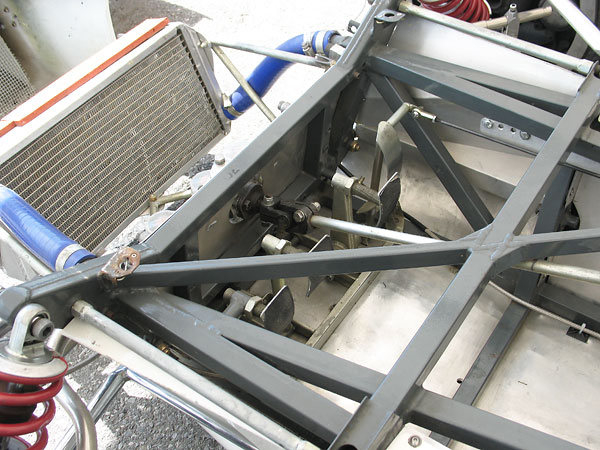
�
A high quality feature: finely and relatively easily adjustable pedals.
�
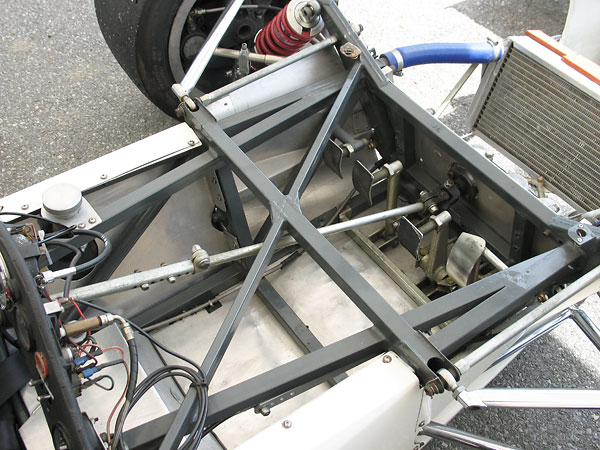
�
Telescoping steering column.
�
�
Exterior
��
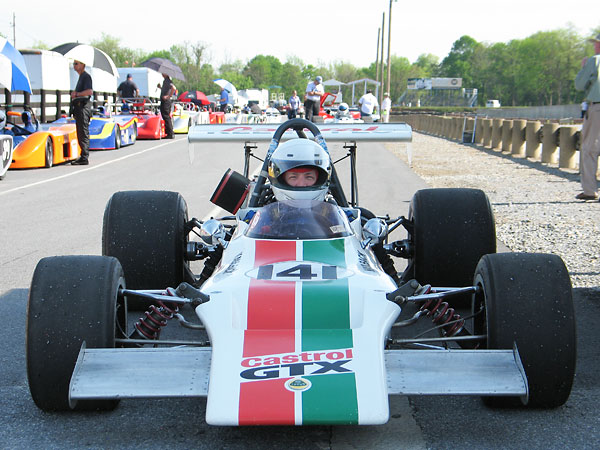
�
Kyle Kaulback at Summit Point, contesting the 2010 Jefferson 500.
�
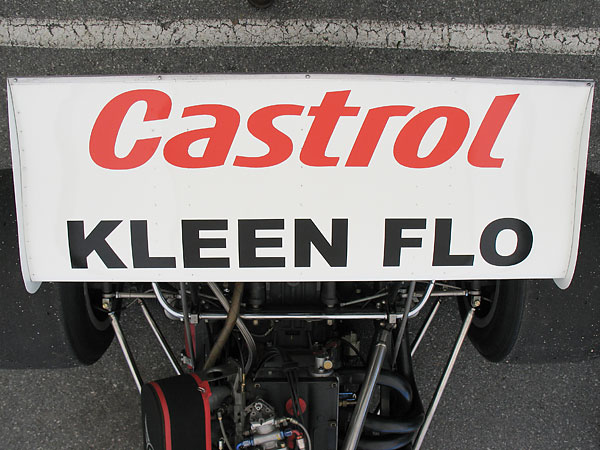
�
Castrol Kleen Flo
�
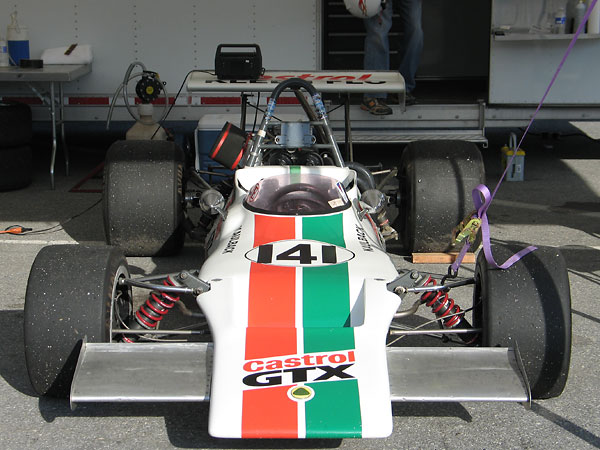
�
Dave Baldwin gets credit for designing the Type 69 models, and also for designing
�
the Type 59 models from which they were derived.
�
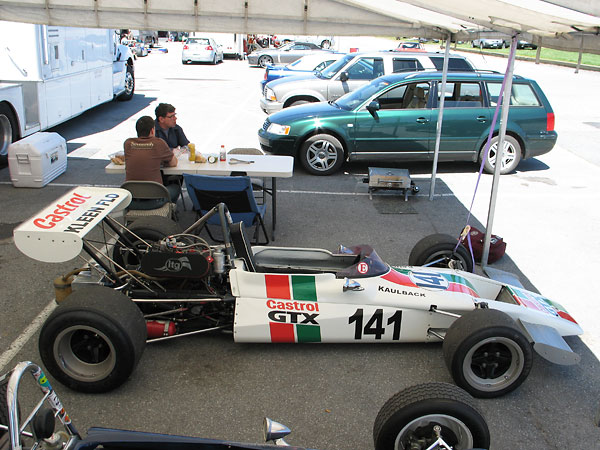
�
How many were produced? The usual estimate is 57 racecars, if you combine all variants.
�
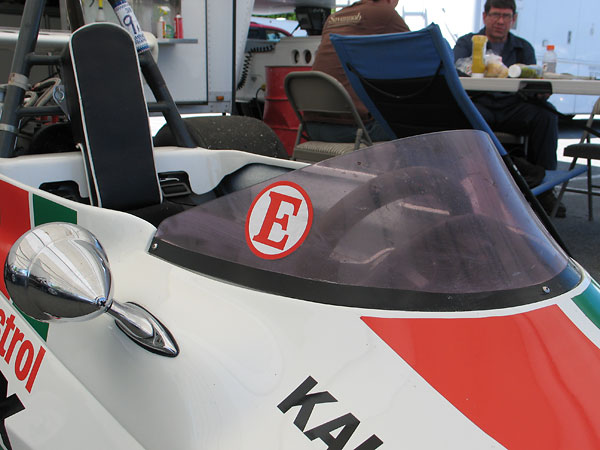
�
This looks Like an original windscreen; shape and tinting match period photos we've studied.
�
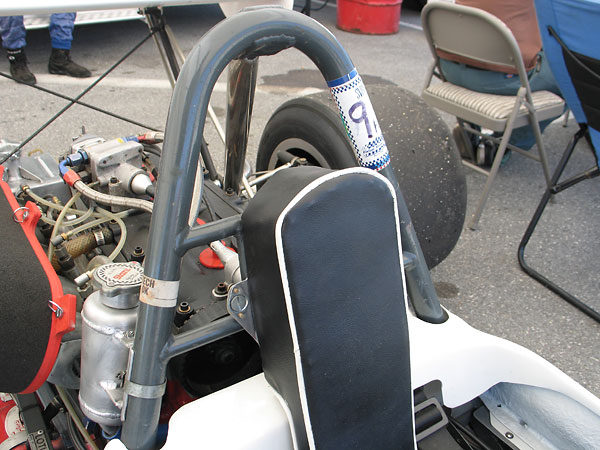
�
This appears to be the original roll hoop, but with a larger and more elaborate headrest.
�
Notice that it's removable by turning two Dzus quarter turn fasteners.
�
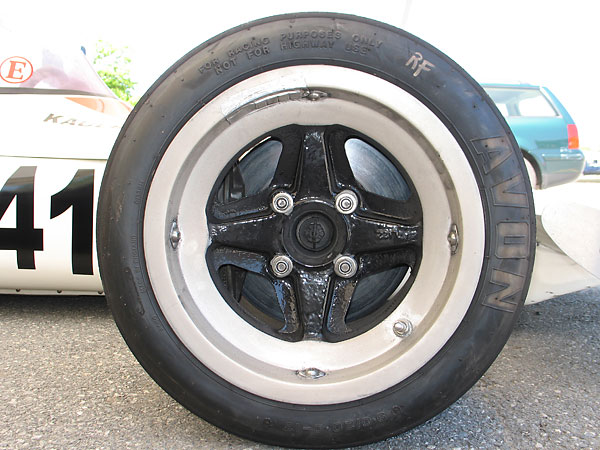
�
Lotus magnesium alloy racing wheels (13x10 front, 13x14 rear), These are mounted on studs, whereas
�
original F2-spec Type 69s came with knock-on hubs. The code "L122" cast into one of the spokes
�
indicates the specific magnesium alloy used. (L122 is 92% magnesium plus 8% aluminum.)
�
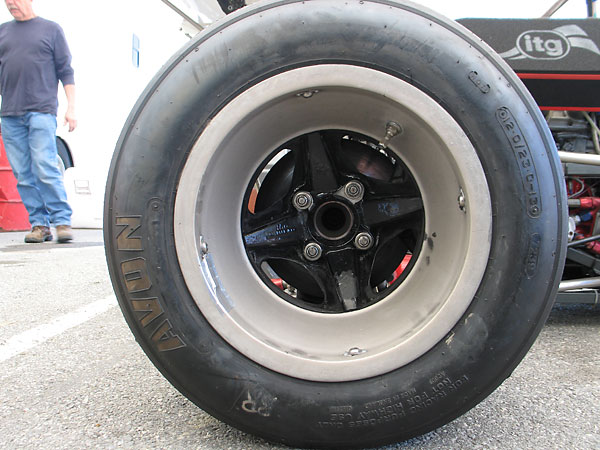
�
Avon racing slicks (9.0/20.0-13.0 front, 12.0/23.0-13.0 rear. ~$950/set)
�
| Notes: | |||||||
| (1) | �
Engine restrictions are one of the main differences between racing classes. �
� F2: from 1967 through 1971, Formula Two cars were permitted to run 1.3 to 1.6 liter engines. By far� the most popular and successful 1.6 liter F2 engine was the Cosworth FVA which featured gear-driven dual� overhead cams and four valves per cylinder, atop a four cylinder Ford Cortina engine block. Generally� featuring Lucas mechanical fuel injection, these engines typically gave at least 220bhp at 9000 rpm.� From 1972, 2.0 liter production-based engines such as the Cosworth BDA (shown above) were allowed.� � F3: Formula Three cars were restricted to one liter displacement engines through 1970. Their highly� tuned and highly strung little engines screamed as they produced about 125bhp. Starting in 1971, F3� teams were allowed to use larger (1.6 liter) engines if 20mm induction restrictor plates were fitted.� The Lotus/Ford Twin Cam seemed like the motor to have. Four throttle bodies would typically draw� air from a common plenum. Air entered the plenum through a single inlet. Clever teams realized this� inlet should be a "converging/diverging nozzle" and that the geometry of its construction was� important. In actual racing conditions, the original 20mm restriction was soon found to be too small.� The newly allowed 1600cc engines were only producing about 110bhp! (The cars were about four seconds� per lap off their previous pace, which wasn't the intent of the rules.) In mid-August of 1971, the� rules were altered and the diameter of the air inlet restriction increased from 20mm to 21.5mm,� where it stayed through 1973.� � FF: by class rules all Formula Fords used essentially stock versions of the 1600cc Ford engine, with� Weber downdraught carburetor, iron crossflow cylinder head, and single camshaft operating valves via� pushrods. In this era, a very well prepared Formula Ford engine would produce 105bhp at ~5900rpm. � � | ||||||
| (2) | �
Chassis number 71-69-5FB shouldn't be confused with chassis number 71-69-5F2,�
which was Emerson Fittipaldi's Cosworth FVA powered, semi-monocoque chassis Formula Two car�
for 1971. Incidentally, Lotus built twelve cars with "71-69-xFB" chassis numbers, versus seven�
cars with "71-69-xF2" chassis numbers. In both cases, "71" in the chassis number designated�
build year 1971. Lotus is generally believed to have also built seven Type 69 Formula Two cars�
in 1970; their chassis numbers followed the pattern "69.F2.x".�
� | ||||||
�
All photos shown here are from April 2010 when we viewed the car at VRG's Jefferson 500�
at Summit Point Motorsports Park, West Virginia. Photos by Curtis Jacobson for BritishRaceCar.com, �
copyright 2011. All rights reserved.
�
| If you liked this article, you'll probably also enjoy these: | �|||||
 | �
Kyle Kaulback 1970 Lotus 61MX | �
 | �
Michael Snowdon 1972 GRD 272 | �
 | �
Gord Leach 1974 Hawke DL11 | �
| You're invited to discuss anything you've seen here on The British Racecar Motorsports Forum! | �|||||
�
Notice: all the articles and almost all the photos on BritishRacecar.com are by Curtis Jacobson.
�
(Photos that aren't by Curtis are explicitly credited.) Reproduction without prior written permission is prohibited.
�
Contact us to purchase images or reproduction permission. Higher resolution images are optionally available.
�

 �
�